




How to Use the Pythagorean Theorem in Everyday Situations
The Pythagorean theorem also known as the Pythagoras theorem explains “the relationship between the three sides of a right-angled triangle which are also referred to as the Pythagorean Triplet”.
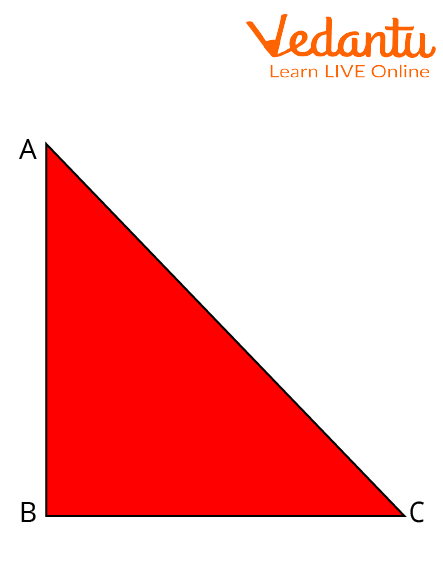
Right-Angled Triangle
In the figure shown above, $ABC$ is a right-angle triangle with right angled at $B$ and $AC$ in the hypotenuse, $BC$ is the base for angle $C$ and $AB$ is perpendicular. $\underline{\underline{\text { So }}}$ in this Triangle according to Pythagoras' Theorem:
$(A C)^{2}=(A B)^{2}+(BC)^{2}$
In this article, we will be discussing the real-life application of the Pythagoras theorem, i.e., the application of the theorem in our daily life.
History of Mathematician
The Pythagorean theorem takes its name from the ancient Greek mathematician Pythagoras.

Scientist Pythagoras
Name: Pythagoras
Born: About 570 BC
Died: About 490 BC
Field: Mathematics and Philosopher
Nationality: Greek
Statement of Pythagoras Theorem
Pythagoras theorem states that “In a right-angled triangle, the square of the hypotenuse side is equal to the sum of squares of the perpendicular and the base, i.e., the other sides of the triangle.”
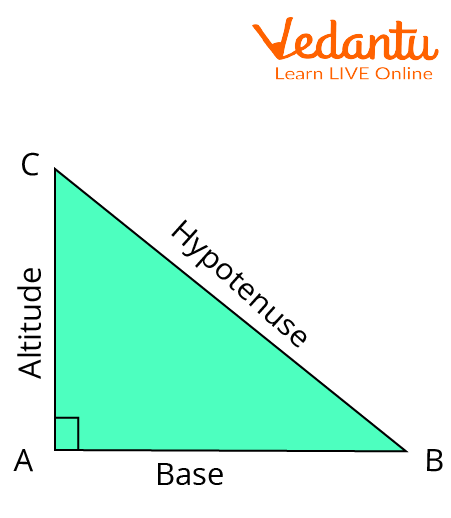
Statement of Pythagoras Theorem
In the above triangle, for angle $B, B C$ is the hypotenuse, $A B$ is the base, and $A C$ is the perpendicular. So,
$(B C)^{2}=(A B)^{2}+(AC)^{2}$
Note: Hypotenuse is the longest side of the right-angle triangle.
The Formula of Pythagoras Theorem
$(\text { Hypotenuse })^{2}=(\text { Base })^{2}+(\text { Perpendicular })^{2} \\$
$(B C)^{2}=(A B)^{2}+(AC)^{2}$
where BC is hypotenuse, AB is base, and AC is perpendicular for right-angled triangle ABC.
Proof of Pythagoras Theorem
Given: A right-angled triangle $\mathrm{ABC}$, right-angled at $\mathrm{B}$.
To Prove: $A C^{2}=A B^{2}+B C^{2}$
Construction: Draw a perpendicular BD meeting $A C$ at $D$.
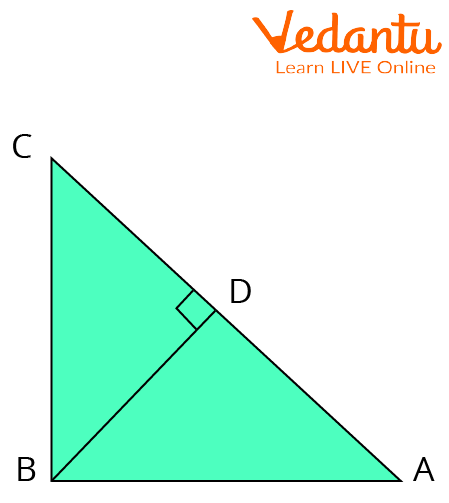
Construction to Prove Pythagoras Theorem
We know $\triangle A D B \sim \triangle A B C$
Therefore,
$\dfrac{A D}{A B}=\dfrac{A B}{A C}$
(Corresponding sides of similar triangles)
Or, $A B^{2}=A D \times A C$
Also, $\triangle B D C \sim \triangle A B C$
Therefore,
$\dfrac{C D}{B C}=\dfrac{B C}{A C}$
(Corresponding sides of similar triangles)
or, $B C^{2}=C D \times A C$
Adding the equations (1) and (2), we get,
$A B^{2}+B C^{2}=A D \times A C+C D \times A C$
$\Rightarrow A B^{2}+B C^{2}=A C(A D+C D)$
Since $A D+C D=A C$
Therefore, $A C^{2}=A B^{2}+B C^{2}$
Hence, we proved Pythagoras theorem.
Now, Let us discuss the converse of Pythagoras Theorem with detailed proof.
Converse of Pythagoras Theorem and Its Proof
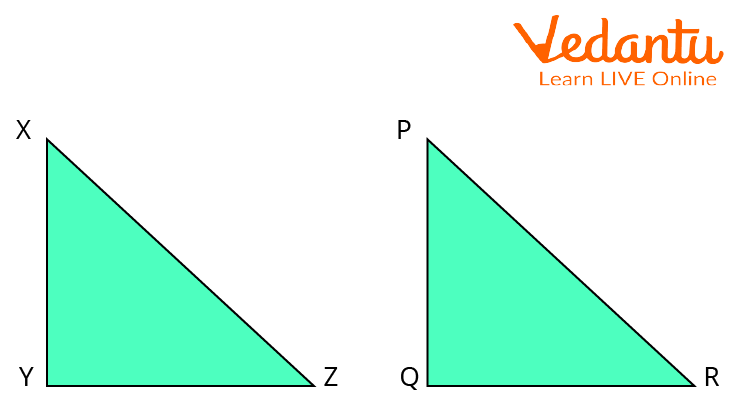
Two Right-Angled Similar Triangles
In a triangle, if the square of one side is equal to the sum of the other two sides, then the angle opposite the first side is a right angle.
Given: $\ln \Delta X Y Z, X Y^{2}+Y Z^{2}=X Z^{2}$
To prove: $\angle X Y Z=90^{\circ}$
Construction: A triangle PQR is constructed such that a triangle $P Q R$ is constructed such that
$P Q=X Y, Q R=Y Z \angle P Q R=90^{\circ}$
Proof: $\ln \triangle P Q R, \angle Q=90^{\circ}$
$P R^{2}=P Q^{2}+Q R^{2}$ {Pythagoras theorem}
or $P R^{2}=X Y^{2}+Y Z^{2} \ldots$ (i) $[P Q=X Y, Q R=Y Z]$
But we know $X Z^{2}=X Y^{2}+Y Z^{2} \ldots \ldots$ (ii) (given)
Therefore, $X Z^{2}=P R^{2}$ {From equation (i) and (ii)}
or $X Z=P R$
or $\triangle X Y Z \cong \triangle P Q R$ {SSS congruence rule}
Therefore, $\angle Y=\angle Q=90^{\circ}$ {CPCT}
Hence, $\angle X Y Z=90^{\circ}$
The converse of Pythagoras theorem is proved.
Application of Pythagoras Theorem
Pythagoras Theorem is used to find the steepness of hills.
In Artificial intelligence: face recognition features in security cameras use the Pythagorean theorem. The distance between the camera and the person is recorded.
Pythagoras Theorem is used to find the shortest distance in Navigation.
The concept of the Pythagoras Theorem is also used in Interior Designing.
Pythagoras theorem is used to find the third side of a right-angled triangle when 2 sides are given.
In Engineering, the diameter can be easily calculated when length and breadth are known using Pythagoras Theorem.
Limitations
Pythagoras Theorem is only applicable in the case of the Right-Angled Triangle. If one of the angles is not 90 degrees, then we cannot use Pythagoras Theorem.
Pythagoras Theorem is only useful in the case of 2-dimensional figures. It cannot be applied in the case of 3-dimensional figures or objects.
Solved Examples
1. The perpendicular of a right-angled triangle is given as 12cm and the hypotenuse is given as 13cm. Find the base of the given triangle.
Solution:
Perpendicular $=12 \mathrm{~cm}$
Base $=b \mathrm{~cm}$
Hypotenuse $=13 \mathrm{~cm}$
As per the Pythagorean Theorem, we have
$Perpendicular^{2}+ Base^{2}= Hypotenuse^{2}$
$\Rightarrow 12^{2}+b^{2}=13^{2}$
$\Rightarrow 144+b^{2}=169$
$\Rightarrow b^{2}=169-144$
$\Rightarrow b^{2}=25$
$\Rightarrow b=\sqrt{25}$
Therefore, $b=5 \mathrm{~cm}$
2. The sides of a triangle are 15, 17, and 8 units. Check if it has a right angle or not.
Solution: Clearly, 17 is the longest side.
It also satisfies the condition $15+8>17$
We know
$c^{2}=a^{2}+b^{2}$
So, let $a=15, b=8$, and $c=17$
First, we will solve R.H.S. of Equation (1).
$a^{2}+b^{2}=15^{2}+8^{2}=225+64=289$
Now, taking L.H.S, we get
$c^{2}=17^{2}=289$
We can see LHS=RHS.
Therefore, the given triangle is a right triangle, as it satisfies the Pythagoras theorem.
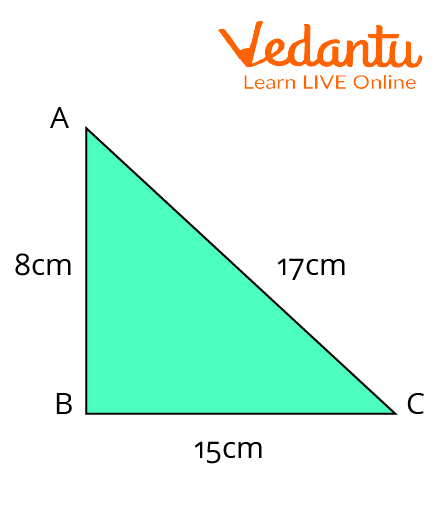
To Check Angle of Triangle
Important Formulas
For any Right-Angled Triangle,
$(\text { Hypotenuse })^{2}=(\text { Base })^{2}+(\text { Perpendicular })^{2}$
Important Points to Remember
Pythagoras theorem is applicable only in case of a right-angled triangle.
Trigonometry is based on the Pythagoras Theorem.
Conclusion
In this article, we discussed the Pythagoras Theorem in depth. The proof, statement, applications, and examples are thoroughly explained above. From the discussion above about the Pythagoras theorem, we can conclude that it is a very useful theorem to be used in solving questions of a right-angle triangle and it helps us in real life a lot.
FAQs on Real-Life Applications of Pythagorean Theorem
1. What are the real life applications of Pythagorean theorem?
The Pythagorean theorem is used in many real-life scenarios, especially when determining the shortest distance between two points. Common applications include:
- Measuring the height of buildings or trees without direct access
- Calculating the length of a ladder needed to reach a certain height safely
- Navigation and construction to ensure structures are correctly aligned
- Designing ramps or sloped surfaces to meet exact specifications
2. What are two different real-world situations in which you could use the Pythagorean theorem?
Two practical situations where the Pythagorean theorem is useful are:
- Mapping and Land Navigation: Surveyors often need to calculate straight-line distances across plots of land. By applying Pythagoras’ theorem, they can easily determine this when only the lengths along two sides of a plot are known.
- Construction and Carpentry: Builders use it to check if corners of rooms or tiles are perfectly square by measuring the diagonals. If the diagonal $c$ in a right triangle satisfies $c^2 = a^2 + b^2$, the angle is 90°.
3. When would I use the Pythagorean theorem in life?
You would use the Pythagorean theorem whenever you encounter right-angled triangles in daily tasks. Examples include:
- Finding the shortest route across a park (walking diagonally instead of around the edges)
- Determining if a piece of furniture will fit through a doorway by measuring the diagonal
4. What are three jobs that might use the Pythagorean theorem today?
Three professions that frequently use the Pythagorean theorem include:
- Architects: To design and verify accurate building layouts and ensure structures are constructed appropriately.
- Athletes and Coaches: Especially in track and field, to calculate optimal running distances and plans.
- Engineers: To find component lengths, distances, and to check for squareness in mechanical designs.
5. How can I use the Pythagorean theorem for home improvement projects?
The Pythagorean theorem is ideal for home improvement, such as:
- Ensuring walls and floors are square by measuring diagonals ($c^2 = a^2 + b^2$).
- Calculating the length of a ladder needed to safely reach a roof when you know the height and the distance from the wall.
- Measuring the diagonal of a TV or table to see if it fits a specific space.
6. What are some unique outdoor activities where the Pythagorean theorem is useful?
Outdoor activities where the Pythagorean theorem is helpful include:
- Hiking or Orienteering: Calculating the straight-line (as-the-crow-flies) distance between two points on a map.
- Building treehouses: Measuring the distance between supports at right angles.
- Sports field marking: Ensuring right angles and accurate field dimensions.
7. Can the Pythagorean theorem be applied to navigation and map reading?
Absolutely! In navigation and map reading, the Pythagorean theorem allows you to determine the direct distance between two points when you know the horizontal and vertical distances. For example, if you travel 3 km east and then 4 km north, your direct distance from the starting point is given by $c = \sqrt{3^2 + 4^2} = 5$ km. Vedantu’s math tutors illustrate these concepts with relatable examples using maps and interactive activities.
8. How does the Pythagorean theorem help in designing ramps for accessibility?
The Pythagorean theorem is crucial in designing accessible ramps. If you know the required vertical rise ($a$) and the horizontal run ($b$), you can use $c^2 = a^2 + b^2$ to determine the exact ramp length ($c$). This ensures the ramp meets safety and comfort standards. Vedantu’s application-based math curriculum often uses ramp design projects to help students understand the relevance of mathematics in community and social infrastructure.
9. What are some classroom experiments to demonstrate the Pythagorean theorem?
Classroom experiments for the Pythagorean theorem might include:
- Creating right triangles with sticks or straws and measuring sides to verify $c^2 = a^2 + b^2$.
- Using graph paper to draw right triangles and calculate side lengths visually.
- Measuring distances in the classroom, such as the diagonal across a rectangular table.








































